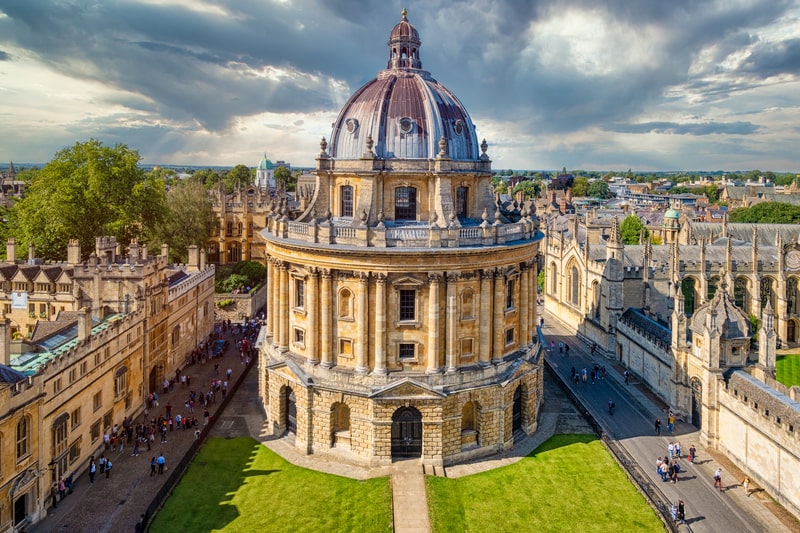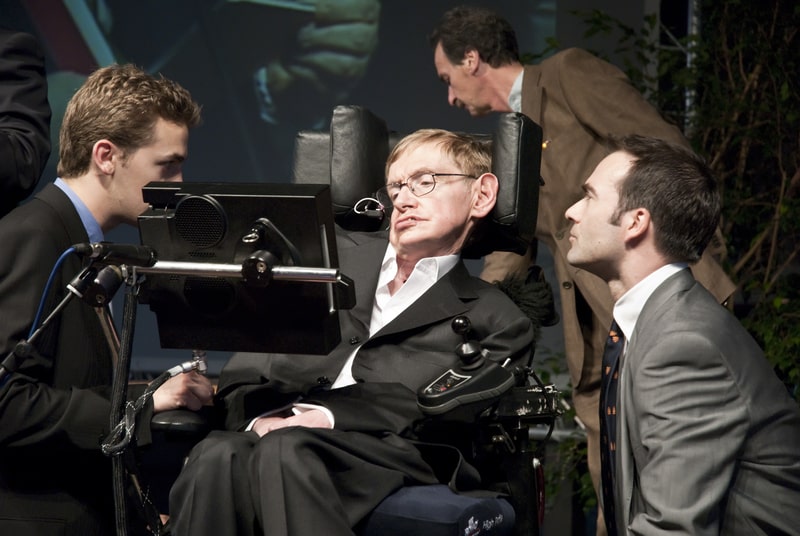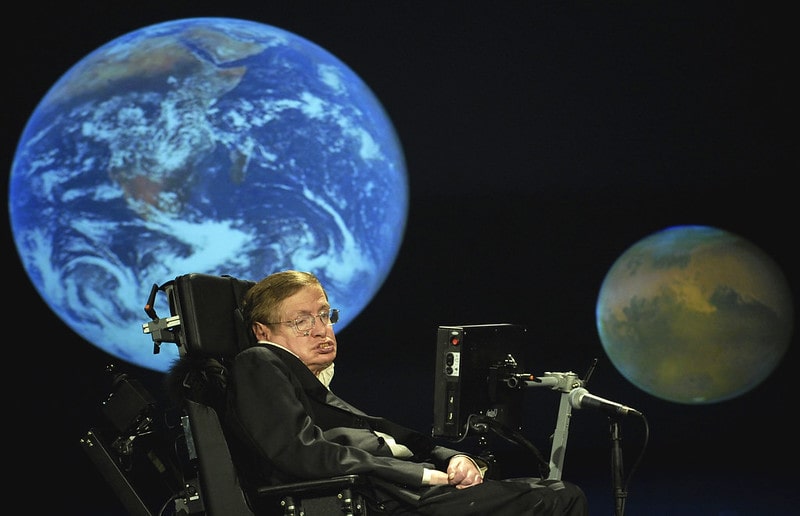Last updated on April 1st, 2023
Stephen Hawking is one of the most recognized names around the world. His name is mostly synonymous with images of a paralyzed man who is stuck in a wheelchair, but his lack of mobility never slowed him down. Hawking once stated that “the human race is so puny compared to the universe that being disabled is not of much cosmic significance.” The magnitude of his fame started with his contributions to cosmology, which is the study of the universe, and his theories related to black holes and stars. His rise to fame is peppered with all kinds of events, such as speaking at important ceremonies, receiving awards, advancing his education and publishing books. Here are 50 facts about Stephen Hawking.
1. Stephen William Hawking was born in Oxford, England during World War II on January 8, 1942, making his zodiac sign the Capricorn.
2. His birthday fell on the exact day that physicist and astronomer Galileo Galilei‘s death occurred 300 years prior, on January 8 in 1642.
3. Both of Hawking’s parents, named Isobel and Frank Hawking, attended the University of Oxford. His mother took on a few different jobs following her graduation but prior to his birth, while his father worked as a research biologist.
4. It was not immediately apparent that Hawking was a genius. At the age of 9, his grades were among the worst in his entire class. After working to improve his grades, Hawking was still only regarded as being average.

5. As a teenager, Hawking’s friends called him “Einstein” after they created a computer using telephone switchboards, old clock parts and additional items that were meant to be recycled.
6. Although he was fond of mathematics and thought about majoring in it, his father strongly urged him to study medicine. His father was mostly concerned about the number of available careers for mathematics graduates, which was considerably low. He also wanted his son to attend Oxford just as he had, but the University did not have a mathematics program at that time.
7. Hawking’s parents could not afford to send him to college, but he was able to go after getting an almost perfect score on his scholarship physics exam and receiving a scholarship.
8. Hawking was not happy during his first year at Oxford, but things started to turn around when he became a member of the Oxford Rowing Team.

9. In 1962, he received his bachelor’s degree in physics from the University of Oxford after completing the mandatory four years of coursework.
10. One year later, Hawking was diagnosed with a motor neuron disease called Lou Gehrig’s Disease, which is also known as Amyotrophic Lateral Sclerosis, or simply ALS. According to the Mayo Clinic, ALS destroys nerve cells and causes disability. The causes were unknown and a cure was nonexistent. Instead, the disease had been known to usually prove fatal after only three years.
11. Hawking would greatly outlive the estimation commonly associated with those who suffered from ALS at the time. The Atlanta Journal-Constitution reported that approximately 6,000 people in the United States are diagnosed with ALS each year, and that only 10 percent of those diagnosed would live for more than 10 years. Hawking went on to defy statistics and survive for 55 years after his initial diagnosis.
12. However, the disease slowly took its toll on his body. First he needed crutches and walking sticks, but eventually he required the use of a wheelchair in order to get around.
13. Over time, Hawking lost all mobility until he was completely paralyzed. He was forced to rely on other people and even technology for absolutely everything, including getting dressed, getting in and out of his wheelchair, taking a bath, eating his meals and even communicating.

14. The condition deteriorated his body so much that eventually, Hawking could only move some of his fingers. Sadly, this ability was limited to only one of his hands.
15. He was known for recklessly driving his wheelchair through the Cambridge streets and rumor has it that he even ran over the toes of fellow students. In one incident, Hawking broke his femur after crashing his wheelchair into a wall. He simply stated that “the wall won.” Unfortunately, there would be many police investigations conducted and countless allegations thrown around regarding the way people were taking care of Hawking over the years. Though he denied any wrong-doing by any of his carers, he would sport countless injuries without ever offering explanations.
16. Hawking received his Doctor of Philosophy, also known as a Ph.D., in physics from Cambridge University in 1966. His doctoral work was in theoretical physics and his thesis concentrated on black holes.
17. Hawking was married twice. In 1965, he married his first wife, Jane Wilde, but they divorced in 1991. Although she was a devoted wife, mother and full-time caretaker for Hawking, Jane could not handle the pressure and ever-growing list of responsibilities that came along with Hawking’s rise to fame.
18. In 1970, Hawking combined quantum theory with the theory of relativity to deduce that, theoretically, black holes should give off radiation.
19. Colleagues originally dismissed Hawking’s theory, but it was later found that based on the current understanding of physics, Hawking was correct. His concept was named “Hawking radiation” and is still considered to be among his largest contributions to the field of cosmology.
20. He joined The Royal Society in London as a Fellow in 1974. According to their website, The Royal Society’s primary purpose is to “recognize, promote, and support excellence in science and to encourage the development and use of science for the benefit of humanity.”
21. Hawking began teaching at Cambridge University in 1979, where he was the seventeenth Lucian Professor of Mathematics. At one time, Isaac Newton held the same position.

22. Hawking had three children with his first wife, Jane Wilde. Their first son, Robert, was born in 1967 and would later become a software engineer. Their second child was a daughter named Lucy, who would establish a career as an author and journalist. Timothy was the youngest child and would take on a number of jobs in the future, including an account manager, a brand development specialist and a loyalty executive.
23. Hawking collaborated with Jim Hartle in 1983 to combine quantum mechanics with general relativity and develop a theory stating that there are no boundaries to the universe, despite it being a contained entity.
24. In 1985, Hawking suffered from pneumonia and was hospitalized. Doctors were forced to perform an emergency tracheotomy, which left him with permanent damage to his vocal cords and larynx.
25. One of Hawking’s nurses and his future wife, Elaine Mason, introduced him to her then-husband, an engineer named David Mason. David refined an electronic speech synthesizer which was operated by a keyboard and attached it to Hawking’s wheelchair, which gave him the ability to communicate.
26. Hawking’s first synthesizer was created in California and ran a program named Equalizer on an Apple computer. He controlled it through the use of a hand clicker that let him select words from a screen.
27. After the disease stole his ability to move his hands, an infrared switch was mounted to his eyeglasses. Hawking controlled this device using a muscle in his cheek.
28. His speech synthesizer spoke with an American accent, which Hawking insisted on keeping the same, even when his equipment was upgraded.

29. Hawking received several awards, such as the Albert Einstein Medal in 1979, a Commander of the Order of the British Empire in 1982 and the Wolf Prize in Physics in 1988.
30. Hawking published his first book in 1988, titled A Brief History of Time: From the Big Bang to Black Holes. It became a best-seller around the world and ultimately sold over 10 million copies. He would joke that the book was the most-purchased but least-read.
31. Hawking guest-starred as himself in a few television shows. The first was in 1993 when he was on Star Trek: The Next Generation. He also appeared in The Simpsons, Last Week Tonight with John Oliver, Futurama and The Big Bang Theory.
32. In 1995, Hawking married his second wife, Elaine Mason. This marriage would only last until 2006.
33. Hawking turned the field of cosmology on its head in 2004, when he personally reversed his 1966 theory that stated black holes swallow anything that gets in their way. He also stated at this time that black holes would never be a means of space travel to a different universe.
34. In 2005, Hawking reworked his best-selling book to be a little bit easier to understand for those who were not scientists. It was aptly named A Briefer History of Time.

35. On April 26, 2007, at 65 years old, Hawking embarked on a Zero Gravity Corporation flight. He was the first quadriplegic to know what zero gravity feels like.
36. In October of that same year, he published a children’s book that he had written with his daughter Lucy, titled George’s Secret Key to the Universe. He and his daughter would eventually publish four additional books.

37. In 2008, Hawking spoke at the celebration of NASA’s 50th anniversary. During his speech, he hinted at the possibility of alien existence, but warned that we should be wary of coming into contact with aliens. Hawking noted that aliens are unlikely to be DNA-based lifeforms, and therefore we would not be resistant to their diseases.
38. He also focused on the subject of aliens during one episode of his Discovery Channel show, Into the Universe with Stephen Hawking. The show was marketed as revealing “the splendor and majesty of the cosmos” and discussing topics such as “alien life, time travel, how the universe began and how everything will end.”
39. Hawking was appointed to the first Distinguished Research Chair at the Perimeter Institute for Theoretical Physics in Ontario.
40. From 2009 until his death in 2018, he was also the University of Cambridge’s Director of Research at the Center for Theoretical Cosmology.

41. President Barack Obama awarded Hawking the highest civilian honor in the United States, called the Presidential Medal of Freedom in 2009.
42. The following year, Hawking published a book he wrote with Leonard Mlodinow titled The Grand Design.
. . . continue reading on the next page
